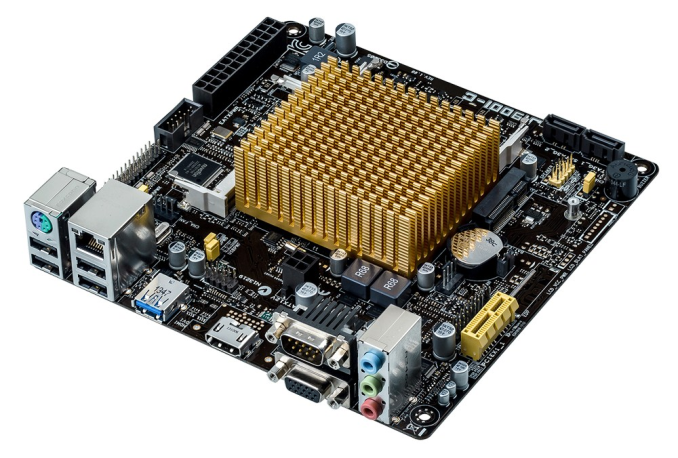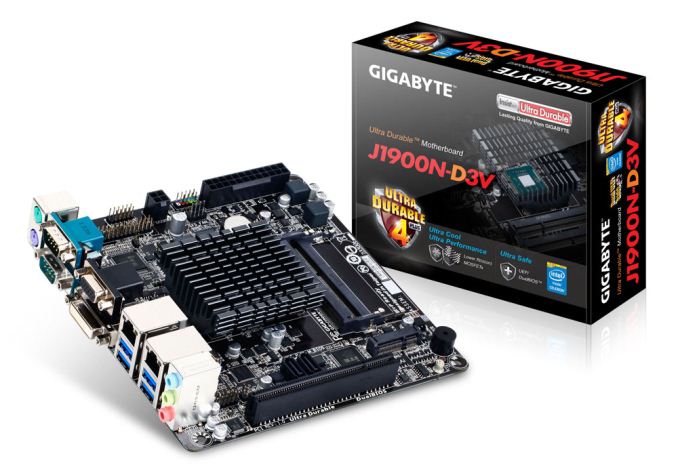The Battle of Bay Trail-D: GIGABYTE J1900N-D3V and ASUS J1900I-C Reviewed
by Ian Cutress on October 17, 2014 10:00 AM ESTConclusion: The Motherboards
With only a few dollars separating our two candidates, one might imagine that they would act very similar to each other and you end up buying more for the brand over the capabilities. To a certain extent that is true, but these boards actually differ quite a lot in terms of their functionality. It all comes down to what extras each manufacturer decided on. The GIGABYTE J1900N-D3V goes with two network ports, a PCI slot, a DVI-D port and a USB 3.0 hub, whereas the ASUS J1900I-C has a single network port, a PCIe 2.0x 1 slot, a HDMI port and fan controls. The best way to compare ends up as a rundown of the feature set:
| GIGABYTE vs. ASUS, J1900 mini-ITX | ||
| GIGABTYE J1900N-D3V | ASUS J1900I-C | |
| Network Ports | 2 | 1 |
| USB 2.0 Ports | 2 | 6 |
| USB 3.0 Porrts | 4 | 1 |
| PCIe 2.0 x1 | 0 | 1 |
| PCI | 1 | 0 |
| Mini-PCIe | 1 | 1 |
| Digital Display | DVI-D | HDMI |
| BIOS Visuals | Text | Designed |
| Fan Controls | No | BIOS + OS |
| Update BIOS in BIOS | No | Yes |
| Control Network Priority | No | Yes |
On the performance side of the equation, almost nothing splits these two boards. CPU results are all very similar, they draw almost the same power from idle to load, but it can be said that the ASUS has the upper hand for POST times and DPC Latency. Both motherboards seem to match each other on audio quality and USB speed.
One area where the J1900I-C surpasses the J1900N-D3V is in the BIOS and software packages. ASUS has this squared down with an easy to understand menu, extensive fan controls and a tool to update the BIOS from within the BIOS. The fan controls in the OS software fully test the fans, and we even get a form of Network management control. In contrast to the GIGABYE board, the BIOS is flat with plenty of confusing options. The GIGABYTE’s software is a little better, but still nothing to direct the fans.
On the counter argument, the GIGABYTE J1900N-D3V is more equipped for network connectivity and USB 3.0. While the four USB 3.0 ports are coming from a hub, the idea here is not for simultaneous access – it allows four high speed devices to be connected at once and when one is needed on its own, it gets the full bandwidth. The only downside here is that for the ASUS and the GIGABYTE boards the on-disk drivers had trouble initializing USB 3.0 on Windows 7, so the latest drivers are needed. ASUS would also argue, in terms of functionality, that a HDMI and PCIe 2.0 x1 would be more welcome for more people than a DVI-D and PCI slot.
The conclusion about which board to buy comes down to common sense. As a day-to-day product for home use, the ASUS would be my choice as the better experience especially if the user had to deal with fan controls or USB 3.0 boost. That being said, the four USB 3.0 ports on the GIGABYTE is a difficult one to concede as it could be very useful for connected devices that require bandwidth. If the BIOS and Software packages were updated to include fan controls, and the BIOS went into GIGABYTE's 'Classic' EFI style, it would probably swing me towards the GIGABYTE. However, for embedded applications that requires increased network connectivity or PCI, the GIGABYTE targets that market well, with the ASUS focusing on HDMI/PCIe.












60 Comments
View All Comments
Antronman - Friday, October 17, 2014 - link
I'd much rather be using a Kabini for some mainstream browsing and multimedia.speculatrix - Friday, October 17, 2014 - link
the first UEFI firmware on the Gigabyte motherboard was just awful, the followup F2 was slightly better, but to make it useable you need the F3 version. Updating can be a problem, I started a discussion about it here:http://www.silentpcreview.com/forums/viewtopic.php...
there was a big discussion about baytrail motherboards on the silentpcreview forums, here:
http://www.silentpcreview.com/forums/viewtopic.php...
rstuart - Saturday, October 18, 2014 - link
"Load Delta Power Consumption" is just jargon - and you don't define it. Googling it return just one page of hits. If they are any indication, it total draw from the wall.But even that figure is meaningless unless you tell us what conditions the test was done under. Eg, was the test setup identical for all systems tested, not just the motherboards in question. What power supply was used? What does load was the system put under?
Also, a comparison of the system at idle versus under load would be interesting. Most of the time my systems are idle.
Bonesdad - Saturday, October 18, 2014 - link
White titled on a white background...valkyrie743 - Sunday, October 19, 2014 - link
the ASUS J1900I-C looks like nice for a simple XBMC box.Mvoigt - Sunday, October 19, 2014 - link
Just slap an Zotac geforce 610 PCI 1gb ddr3 in the pci slot and you got and decent machine for sligthly older games.... :) even never ones at low res....evident - Sunday, October 19, 2014 - link
I would have loved to see J2900 numbers in this article as well to represent the top end of these bay trails. I still don't care what anyone says, I still don't feel this is a viable platform for granny's daily web surfing and farmville activities, let alone a HTPC. you just cant justify miserable performance when you can step up to a sandy bridge celeron for way better performance.if you look at real world pricing for J1900 based machines, the only winners are the pc box manufacturers charging $200-300 for this garbage. you can easily pick up a haswell pentium or last generation ivy bridge pentium for that price if you wait for a clearance.
abufrejoval - Tuesday, October 21, 2014 - link
I'd love to see those, too. Even more I'd like to be able to actually purchase J2900 hardware, but I have yet to see any.dealcorn - Monday, October 20, 2014 - link
Several posters have suggested that Kabini may be more attractive than Silvermont. In the real world where companies report revenues quarterly, Baytrail-D and Baytrail-M took significant market share from AMD during the second quarter of 2014. The trend accelerated as Atom claimed increased market share during the third quarter and I believe Dr. Su projects this share loss trend will continue in the fourth quarter. The reasons this occurred are not discussed in the Article but are sort of obvious if you look at real word pricing and real word consumer preferences.Today, Newegg will sell you a AMD’s Kabini 5350 for $65 and a BIOSTAR AM1MHP motherboard with Gb Ethernet for $32 making the 5350 a $97 platform. Alternately, you could buy a ASRock Q1900M with a single Gb Ethernet connection for $70. The real world 5350 platform costs $27 (38%) more. I would argue that ASRock is a preferred brand name over Biostar and perceived brand quality does matter at the low end. Obviously, the 5350 has better graphics for gaming but the J1900 supports 1080p video or better in all major codecs. Because the J1900 is significantly cheaper and has fully adequate graphics for everyone but gamers, sales of the 5350 are limited to cheap dedicated gamers and the 5350 dominates the cheap dedicated gamers segment. Problem is, gamers tend not to be that cheap. For a few dollars more than $97 you can step up to a super gimped Intel big core solution with discrete graphics card and far greater game potential than the 5350 solution. In the real world, it does not help to dominate a market niche with trivial sales volume and the quarterly earning releases of AMD and Intel powerfully make this point.
As a side note, the J1900 motherboards tested in the Article feature dual NIC's and that is an expensive feature in this price class. By way of contrast, Newegg sells no AM1 motherboards with dual NIC's. Because J1900 is very efficient, some folks leave them powered on 24/7 so they can act as a passively cooled firewall/router download station. Finally, Intel does not use contra-revenue with either Baytrail-D or Baytrail-M, These are full margin products. Anyone who asserts otherwise just got hit kinda hard with the stupid stick.
silverblue - Monday, October 20, 2014 - link
I can buy a 5350 for about £40 and a Biostar AM1ML board for £20. An MSI J1900I costs a little under £60, so you can get into both for about the same price. I suppose it depends on features in the end.As it is, AMD should cut at least £5 off the RRP.